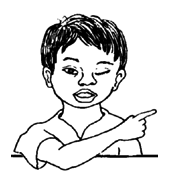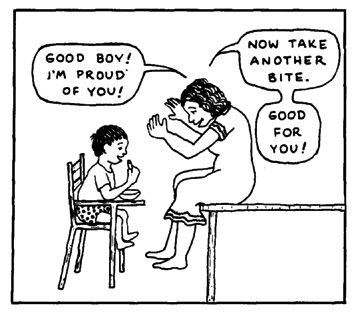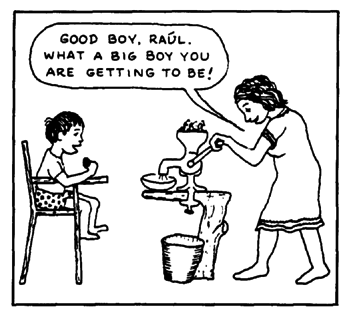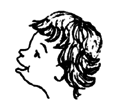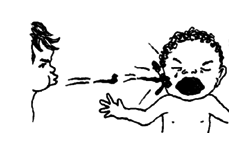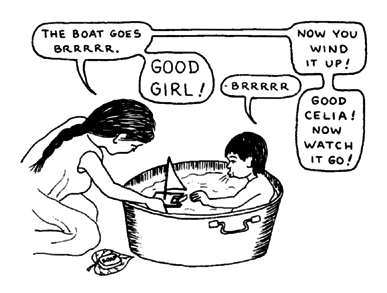CHAPTER 40
Ways to Improve Learning and Behavior
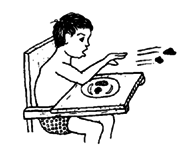
"I still feed Raúl myself because when I let him try to eat by himself he throws his food all over the place. The more I punish him the worse he gets."
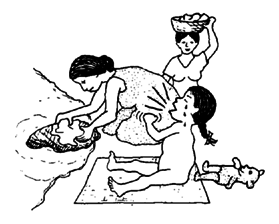
"Erica begins to cry and scream every time I put her down for a minute. It's worse when I take her out where there are other people. At the river she has such tantrums that I can't finish washing the clothes."
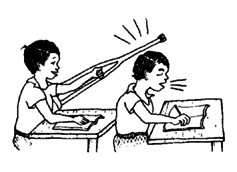
"Jorge is always starting fights with other children or doing other bad things-at home and in school. He seems to enjoy making people mad at him!"
These and other behavior problems can occur in both non-disabled and disabled children. But some disabled children have special difficulty learning acceptable and appropriate behavior. Children who are mentally retarded may develop poor behavior because they are confused by the unclear or conflicting messages they get from their parents and others. Children who are physically disabled sometimes act in 'naughty' or self-centered ways because they have become dependent on others to do things for them. They lack self-confidence, and are afraid of being forgotten. On the other hand, children who are often neglected or ignored when they are quiet and behave well, may learn to behave badly to get attention.
As a rule, if children repeatedly behave badly, it is because they get something satisfying or rewarding from their bad behavior. Therefore, to help children learn acceptable behavior, we need always to CLEARLY LET THEM SEE THAT 'GOOD' BEHAVIOR IS MORE SATISFYING THAN 'BAD' BEHAVIOR.
In this chapter we explore ways to do this, using a 'behavioral approach' which you can divide into 5 steps:
- Carefully observe the circumstances of your child's unacceptable behavior.
- Try to understand why your child behaves as he does.
- Set a reasonable goal for improvement based on his immediate needs and his developmental level.
- Plan to work toward the goal in small steps, always rewarding 'good' behavior and making sure 'bad' behavior brings no pleasure, attention, or reward.
- After the child's behavior has improved, gradually move toward a more natural (less planned) way of relating to him.
A BEHAVIORAL APPROACH TO LEARNING AND IMPROVED BEHAVIOR
Step 1. Observe the circumstances of your child's behavior.
To help your child to behave more acceptably, start by carefully observing what is happening around and with the child when he begins his acts of disturbing behavior. Observe carefully for a week or two. To notice patterns more clearly, it helps to write down your observations. Try to make your records clear, specific, and simple. Take note of everything that might lead to your child's acts of 'bad' behavior, and what he seems to gain from it. For example, Raúl's mother might write these notes:
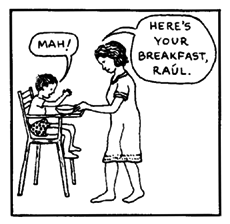
"I put him in his chair, and gave him food." |
|
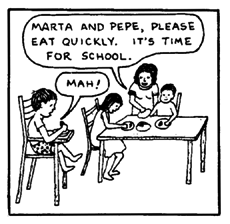
"Then I got the older children ready for school." |
|
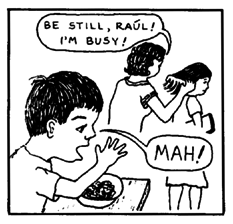
"He kept calling to me, but I was busy and told him to keep quiet." |
|

"Raúl began to throw his food!" "I slapped him." "He started crying. To quiet him, I fed him his breakfast." |
|

"Then I put him down to play with his toys." |
Step 2. Based on your observations, try to figure out why your child behaves as he does. Look for answers to these questions:
| What happens that leads to or 'triggers' his unacceptable behavior? | |
| Is his behavior partly due to confused or unclear messages from you or other persons? | |
| What satisfying results does his behavior produce that might make him want to do it again? | |
| Is the child's behavior partly from feeling afraid or insecure? |
By repeatedly observing what happened before Raúl began to throw food, his mother started to find some answers:
| "Raúl throws food most often when I leave him alone with it-especially when I am busy with the other children." | |
| "My own messages to Raúl are confusing and contradictory. At the same time that I scold him, I also give him the attention and care that he wants-like feeding him as if he were still a baby. | |
| By throwing food, Raúl gets a lot of satisfaction. |
POSSIBLE EXPLANATION FOR RAÚL'S FOOD THROWING
TRIGGERS
|
WHAT HE LOSES BY THROWING FOOD
|
WHAT HE GETS
|
Step 3. Set a goal for improvement of the child's behavior.
If the child has several different behavioral problems, it is usually best to try to improve one at a time. Be positive. Try to set the goal in terms of the good behavior that you want, not just the bad behavior that you wish to end. For Raúl, the goal might be 'to learn to feed himself quietly' (not simply 'to get him to stop throwing his food').
Be sure that goals are possible for the child at his developmental level. (See Page 354.)
Step 4. Plan a way to help the child improve his behavior.
Consistently reward 'good behavior'. Each time the child behaves as you want, immediately show your appreciation. Rewards can be words of praise, a hug, a special privilege (perhaps the chance to play with a favorite toy). Or give the child a bit of favorite food. However, food rewards should mostly be used only for very thin children or if nothing else works. Avoid giving food as rewards to fat children (see Page 340).
As much as possible, ignore rather than punish 'bad' behavior. Rewarding 'good' behavior rather than punishing 'bad' behavior brings improvement with much less bad feeling for both parent and child.
Always reward 'good' behavior and never reward 'bad' behavior. This is the key to the behavioral approach.
For example, whenever Raúl eats by himself, without throwing his food, the whole family can applaud and praise him.
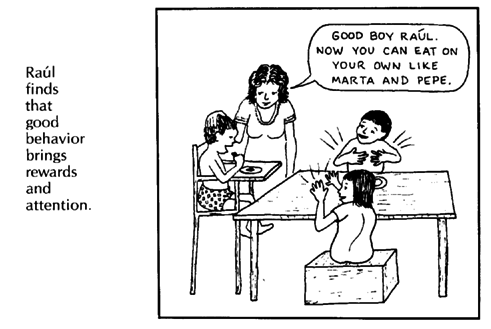
But whenever he throws his food, the family ignores him, except perhaps to say "I'm sorry you did that, Raúl," or, "Once more and I'll have to take your food away because I'm tired of having to clean up the mess." (Make this a result, not a punishment.) Always do what you say you will do.
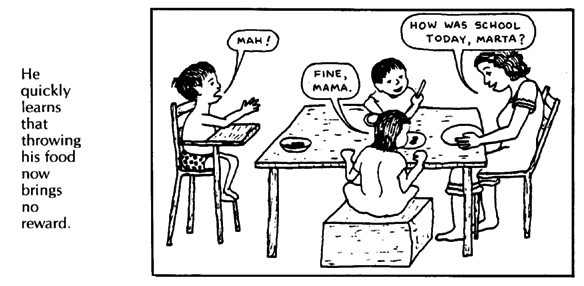
ADDITIONAL GUIDELINES:
| Be consistent in how you respond to your child's behavior. if you sometimes reward good behavior and at other times you ignore it, or if you sometimes ignore bad behavior and at other times either scold or do what the child demands, this is confusing. His behavior is not likely to improve. | |
| WARNING: When using this approach, at first the child may actually behave worse. When Raúl does not get his mother's attention by throwing his food, he may try throwing his bowl too. It is very important that his mother not give in to his demands, but rather be consistent with her approach. Only if she is consistent will he learn that he gets more of what he wants with 'good' behavior than with 'bad'. | |
| Move towards the goal little by little, in small steps. If steps forward are small and clearly defined, often the child will learn more easily, and a beginning period of worse behavior can sometimes be avoided. |
For example, it would be too much to expect Raúl to suddenly eat by himself quietly when mother is busy with the other children. Instead, mother can help him work toward this goal little by little.
| A possible first step is for Raúl's mother to give him his
food after the other children have left for school. This way she
can stay close to him as he eats it.
|
| The next step might be for mother to do her work while Raúl
eats, but to keep talking with him and praising him when he does
well.
|
In this way, Raúl will learn that eating by himself does not mean being left alone, but gets more attention from his mother than does throwing food.
Step 5. After the child's improved behavior has become a habit, gradually move toward a more natural way of relating to the child.
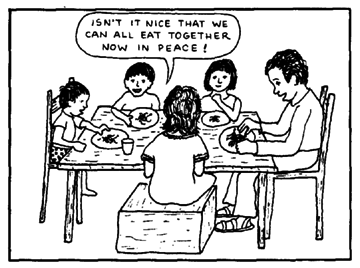
To help the child improve his behavior, the 'behavioral approach' just described often works well, Your responses to your child's acts are carefully planned and consistent. However, such a controlled approach to person-to-person relationships is not natural. Parents and children, like other people, need to learn to relate to each other not according to a plan, or because each action earns a reward, but because they enjoy making each other happy.
Therefore, the last step, after the child's new behavior has been established, is to gradually decrease immediate rewards while sharing the pleasure of an improved relationship.
Setting reasonable goals -based on the child's developmental level
Be realistic when setting a goal for improvement in behavior, or a new skill that you want your child to learn. First try to determine the child's developmental level, and set a goal consistent with that level. (To determine the child's developmental level, see Chapter 34, "Child Development and Developmental Delay.")
Consider Erica, the girl on Page 349 who has tantrums (crying and screaming fits) whenever her mother puts her down. Erica is retarded, which means she is developmentally slow for her age. Depending on her developmental level (not her age), her mother can plan steps to help her avoid tantrums:
Suppose Erica is at the development level of a very young child. She has poor hand control and no ability to play by herself, or to imitate (to copy) others. She will need to begin with very basic steps and clear, simple messages. Her mother can put her down briefly, then praise, talk, or sing to her as long as she does not have a tantrum. When she does have a tantrum, her mother should try to give her as little attention as possible, and never give in to her demands. She can pay attention and reward her during those moments when she stops screaming- if only to catch her breath. This way Erica will begin to learn that she gets more of what she wants through good behavior than through tantrums.
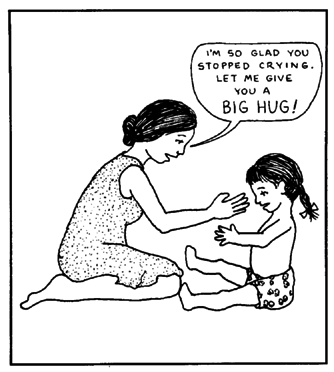
Now suppose that Erica is at a more advanced level of development. She likes using her hands and imitating her mother. Steps for improving her behavior can start from this level. Perhaps her mother can have Erica sit at the river's edge and pretend to help her mother wash clothes. This way Erica will feel closer to her mother and will be less afraid of being left alone. Her mother can talk to her and praise her all the time.

Note: At this level, Erica will not be able to stay with one activity for very long. To avoid tantrums, her mother will need to keep the activities interesting by changing them often, and talking to her a lot. In all of this, other children can be a big help.
Helping the child make sense of his world
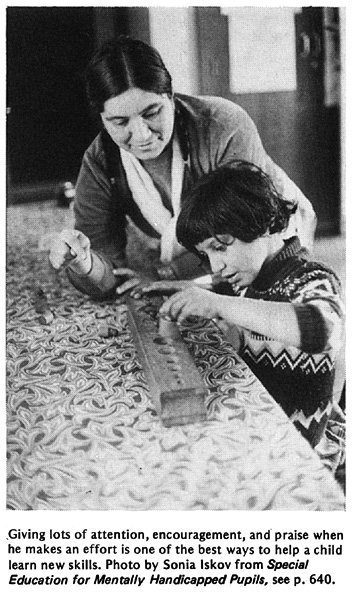
The 'behavioral approach' to learning and development that we have discussed is similar to what is called 'behavior therapy' or 'behavior modification'. However, we prefer to put the emphasis on improving communication to help the child make sense of the world around him. Instead of our 'changing the child's behavior', we would rather help the child to understand things clearly enough so that he chooses to act in a way that will make life more pleasant for everyone.* To achieve this, parents first learn to understand and change their own behavior in relating to their child. They look for ways to communicate with the child that are consistent and supportive, and that reinforce good behavior.
A behavioral approach can often help children who are mentally retarded or developmentally delayed, such as Raúl and Erica, to relate to other persons better and to learn basic skills more quickly.
The approach can be used at almost any age. It is often easier with younger children (developmental age from 1 to 4). Starting at a young age can prevent small behavioral difficulties from becoming big problems later. For the very young or severely retarded child, goals must be kept basic, and progress toward the goals must be divided into small steps. To master each step, much repetition may be needed with consistent praise and rewards for each small advance
Mentally normal children with physical disabilities sometimes also develop unacceptable patterns of behavior. A behavioral approach may help them also. The story on the next page tells how this approach helped Jorge, from Page 349, to behave better.
![]()
THE STORY OF JORGE
Jorge is an intelligent 10-year-old whose legs are paralyzed by polio. He lives with his grandmother. He is noisy, rude, bad tempered, and whenever he plays with other children, it turns into a fight. Jorge has caused so much trouble in the classroom that his teacher recently told his grandmother he will throw Jorge out of school if he does not change. Both his teacher and grandmother have tried scolding him and whipping him, but it only seems to make Jorge's behavior worse. As his grandmother says, "He loves to make people angry at him."
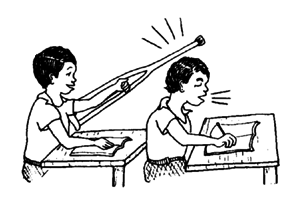
Not long ago, Jorge's grandmother took him to the village rehabilitation center to ask for advice. A village worker helped her to observe both Jorge's and her own behavior more closely to better understand why Jorge acts the way he does. She realized:
| When Jorge is quiet and well-behaved (which is not often), everyone ignores or forgets him. | |
| As a result, Jorge feels unwanted, unloved, and useless. Starved for emotional human contact, he gets it by making people angry with him. | |
| Jorge's bad behavior, therefore, brings him a lot of person-to-person contact, even though it is painful. The few times he tries to be good, he is made to feel unwanted and unneeded. |
"I really do love him," said his grandmother. "But I guess I don't show it much. He makes me worry so much!"
To begin to behave better, Jorge needed to find out that friendly and helpful behavior can bring him closer to people than bad behavior. For this reason, the village worker-together with the grandmother, the schoolteacher, the schoolchildren, the rehabilitation team, and Jorge himself-helped figure out ways that would let the boy see that 'good' behavior is better than bad' behavior.
At home, grandma began to look for things Jorge could do to help her, and to show him how happy she was when he did them. She made a backpack, open at the sides, so that he could help bring firewood. Also, she learned to quietly turn her back when he misbehaved, and to let him know how happy she was when he would sit quietly doing his homework or shelling the maize.

At school, the teacher discussed with the other children ways to include Jorge in their games. When they all played football (soccer), they let him be 'goalie'. To everyone's surprise, Jorge was an excellent goalie. With his crutches he could reach farther and hit the ball farther than anyone else. Soon all the children wanted Jorge to play on 'their team'. At first Jorge started a few fights. But when he did, he was quietly asked to sit on the sideline. Soon he learned to stop hitting other children so that he could keep hitting the ball.
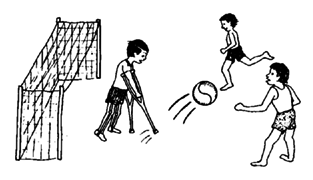
In the village rehabilitation center, the village worker invited Jorge to help make educational toys for young and disabled children. He helped Jorge get started and praised him for each toy Jorge completed. Soon Jorge learned to make the toys by himself and took great pride in his work. When he saw other disabled children playing and learning things with his toys, it made him very happy. He decided he wants to be a rehabilitation worker when he grows up.

'Time Out' or 'non-reward' instead of punishment
The story of the way family and friends used the 'behavior approach' to help Jorge sounds fairly straightforward and simple. But in real life it is seldom that easy. 'Bad' behavior may sometimes be so bad that it cannot be ignored.
In general, the best way to make 'bad' behavior seem boring to the child and not worth the trouble is to give no rewarding response. At the same time, make sure to reward 'good' behavior. This means everything satisfying stops as a result of 'bad' behavior (instead of the usual situation where everything satisfying starts).
For example, when Raúl throws his food, instead of entertaining him by scolding and feeding him, his mother should remove both the food and herself for 3 or 4 minutes-making the situation as boring as possible.
Removing food may seem like punishment. But it is best to aim at making the situation less interesting rather than making it unpleasant. To make things less interesting, sometimes we may remove the child from the situation for a brief time. This is often called 'time out'.
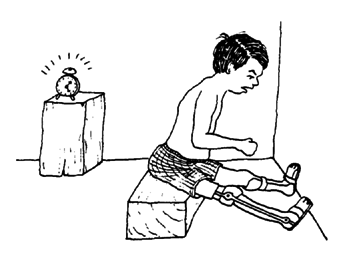
For example, when Jorge's grandmother first began using the behavioral approach, to try to make her angry he would shout and hit the chickens with his crutches. But instead of her usual scolding, grandma now simply told him that if he did not quiet down she would ask him to take 'time out' in the corner. Then, if he continued to make trouble, she would lead him to the corner and tell him that he would have to stay there for 5 minutes from the time he was quiet. She set an old alarm clock to ring in 5 minutes. At first Jorge would continue to shout from the corner, but each time he did, grandma would set the alarm to ring in another 5 minutes from the time he was quiet. Meanwhile she gave him no attention and continued her work.
In this way Jorge learned while he was in the corner that the only way to make life interesting again was to stop making a disturbance. Because he was clever, he learned fast. (Slower children often take longer.)
We should try to use 'time out' as a 'non-reward' and not a punishment. However, because time out is something an adult makes a child do, it can seem like punishment. Try to use it only when less forceful methods of avoiding rewards do not work. It is best to start with a 'time out' period of no more than 5 minutes (less for a very young child). If the child does not behave better in 5 minutes, consider with the child adding another 5 minutes. Never leave the child in 'time out' for more than half an hour, even if he has still not become quiet.
| CAUTION: For a child who is younger than 5 years old or severely retarded, do not extend time out to more than 15 minutes, checking frequently with the child to see if he is ready to behave acceptably. |
A BEHAVIORAL APPROACH TO CHILD DEVELOPMENT AND LEARNING NEW SKILLS
In this chapter we have talked mainly about correcting 'bad' behavior. However, the behavioral approach can also be used to help children learn basic skills for their continuing development. The approach is often useful for children who are slow to develop-for either mental or physical reasons.
In Chapter 34 on child development, we introduced the key features of a behavioral approach: (1) make messages clear, (2) consistently reward things learned, and (3) advance toward new skills through small steps. You will also recognize this behavioral approach in the chapters on 'feeding', 'dressing', and 'toilet training'. Here we would like to review ways of applying a behavioral approach to a child's basic development and learning.
Looking at the whole child to decide where to begin
In considering how to help a child's development, start by looking at what the child can and cannot do. In terms of behavior, we can group our observations into 4 sections:
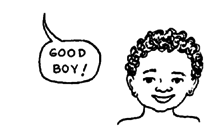
| Positive behaviors: Skills and characteristics the child now has-particularly those that may help him in learning something new. (For example, he enjoys being praised.) |

| Negative behaviors: Things he does that are dangerous, disturbing, or prevent his progress. (For example, breaking things, hitting people, screaming when bathed, throwing toys rather than playing with them.) |
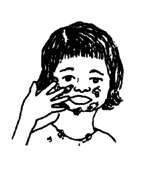
| In-between behaviors: These have both positive and negative aspects, and need to be worked with to make them more positive. (For example, for a child who is beginning to feed herself, but who smears food all over: we encourage feeding herself (which is positive), but not smearing (which is negative). Even screaming or crying in order to express a need might be considered positive for a child who has great trouble communicating. We need to help this become more satisfactory communication.) |
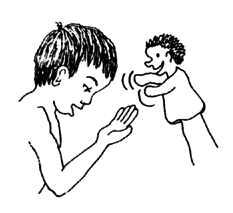
| Key needs: These are problems in the child's behavior that need to be solved to make progress with learning. They differ depending on the stage of development. (For example, for a child to learn from his mother, he needs to respond to his own name, to look at her when she speaks to him, and to stay still and give attention for at least a few seconds. These 'key needs' suggest the first steps in learning to speak, play, or develop new skills.) |
It may help to write a list of these different behaviors. Here is a list that a little girl's mother made with the help of a village health worker who studied this book.
Child: Celia
Age: 4
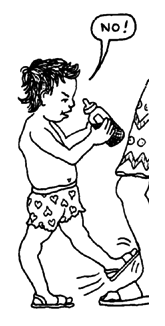
| POSITIVE BEHAVIORS -ones she now has
that we can build on
|
||||||||||||||||
IN-BETWEEN BEHAVIORS-ones that have both
good and bad points
|
||||||||||||||||
NEGATIVE BEHAVIORS-ones that prevent her
progress or disturb the family
|
||||||||||||||||
KEY NEEDS (in order that new
skills and behavior can develop)
|
||||||||||||||||
Deciding where to begin
After they listed these behaviors and considered Celia's key needs, the health worker helped her mother plan where to begin. He explained that, since we cannot change everything at the same time, we need to decide what things need to be done first (choose priorities for action). So we choose the behavior we most want to introduce or change.
| If we are trying to introduce a new behavior or skill, we need to think of all the different parts that make up the behavior. Next we plan the separate small steps that lead to the skill. We encourage the child to advance step by step, making clear what we expect for each step and consistently giving praise and small rewards. | |
| To improve an 'in-between behavior', we can help the child by working with a skill she has already developed a little. First we need to think about the various parts of her behavior that concern us. Then we decide which parts seem helpful and which do not. We then reward the good behavior and ignore the bad. As the child gradually improves, we can expect more of her before giving a reward, until the whole improved behavior is achieved. | |
| If we are trying to reduce or stop an old behavior we need to do 2 things. First we note when and where the behavior happens, and what happens before, during, and afterward. We observe carefully both what the child does and what we ourselves do. Second, we try to guess what the child gains from her 'bad' behavior. We can then try to change things so that 'good' behavior is more worthwhile than the 'bad'. To do this we reward the new 'good' behavior and refuse to give attention for her 'bad' behavior. |
Thinking about Celia's behavior, her mother realized that she already has the beginnings of many valuable skills. She uses her hands well and has begun to develop skills for feeding and dressing herself. She also speaks a few words-although it would be nice if she could say "yes" as well as "no."

It is important that she likes praise and hugs, and bathing, and rough play. This means she will probably learn well with a reward-based approach.
However, certain things seem to be stopping Celia from developing her skills more. Not being able to sit still and give attention makes it hard for her to learn from other people, or even to learn to enjoy her toys (which she always throws). Also, her baby bottle is a big problem. She is much too old for it, but her mother is afraid to take it away because Celia screams. Her mother fills the bottle with sweet drinks (which have already begun to rot Celia's teeth). The biggest problem is that by always holding her bottle, Celia's hands are not free to do other things-such as play with her toys or take down her panties when she has to pee-pee.
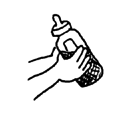
For these reasons, Celia's mother decided that the 'key needs', which need to be solved in order to advance in other areas, are:
| helping Celia learn to sit quietly and give her attention to something | |
| helping Celia grow out of her need to always hold her bottle |
The health worker discussed with Celia's mother what she might do. To help Celia learn to sit quietly and pay more attention to things, her mother decided to start with the times when Celia was already willing to sit fairly quietly-which was mealtime and bathtime. For example:
| After giving Celia her food, but before her
final 'sweet', her mother or her older brother, Oscar, plays
quietly with her for 5 minutes or so, praising her whenever she
gives attention.
|
| Her mother also uses bathtime as an opportunity
to help her concentrate on toys and to give attention to words
and sounds.
To make a paddle wheel boat, |

Celia's mother decided to help her outgrow the bottle little by little. For a start, she filled it with water only. After a few days, she refused to fill it at all.
At first Celia screamed and kicked. But her mother did her best not to give Celia any attention when she acted that way. As soon as Celia was quiet, however, she would give her a tasty drink from a glass, or some other reward.
Sometimes Celia would throw her empty bottle in anger. But after a while she began putting it down, more and more often, to pick up other toys or objects. Finally, her mother simply removed the bottle from sight.
After Celia had forgotten her bottle, she started to explore more with her hands. When she needed to go 'pee-pee', she began to lower her panties by herself; in a few weeks she was 'toilet trained'. She also began to play with her toys more, instead of just throwing them. As she learned to give longer attention to things, she discovered lots of things that gave her pleasure. Many of her behavior problems such as screaming, spitting food, and kicking began to disappear. Her mother, father, and brother spent more time playing and talking with her. They praised her when she behaved well, and did their best to ignore her 'bad' behavior.
Where it seemed necessary, her mother began to use a behavioral approach to help Celia develop other skills: dressing, eating, and talking. To increase her language skills, together they looked at picture books and listened to songs.
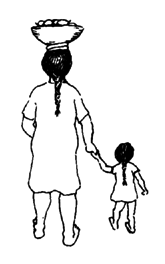
As a result of her family's efforts, Celia has grown up a lot, and is a much happier and more able little girl. Thinking about the changes that took place, her mother said, "I think my behavior has changed as much as Celia's. I was still treating her like a baby-bottle and all! Now that I expect more from her and show her how much I appreciate her effort, she has developed a lot faster, and is a lot easier to live with. She and I have both come a long way!"
![]()
Examples or methods for helping children develop basic skills using a behavioral approach are discussed in other chapters: Feeding, Chapter 36; Dressing, Chapter 37; and Toilet Training, Chapter 38. We suggest you also read again the chapter on child development, Chapter 34, and consider how a behavioral approach can be useful for helping a child through many difficult areas of development.
PARTICULAR BEHAVIOR PROBLEMS THAT OCCUR IN SOME DISABLED CHILDREN
Tantrums
'Tantrums' are fits of crying, screaming, and angry or destructive behavior. The child may try to break, throw, kick, bite, or in other ways damage anything or anyone within reach-sometimes including himself.
Tantrums can be frightening, both to the child and the family. After a tantrum begins, it is difficult to 'reason' with the child and calm him. Punishment often makes it worse.
Children-including some retarded and physically disabled children-may learn to use tantrums to get what they want. Erica, on Page 354, is one example. Here is another:

In this way children discover that tantrums get them what they want. To help a child have fewer tantrums, parents need to help the child find other, more acceptable ways of showing his wants and fears. And most important, parents need to reward the acceptable ways, and at the same time refuse to give the child attention when he is having a tantrum. Let's look at how Kwame's mother learned to do this:
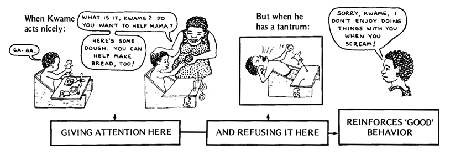
Thus, by rewarding Kwame's good behavior and by refusing to give attention to his demands when he does have tantrums, Kwame's mama helped him learn that tantrums do not get him what he wants. At first he had more violent tantrums than ever. But when even these failed to give exciting results, little by little he stopped having tantrums. He found that other forms of communication gave more satisfying results.
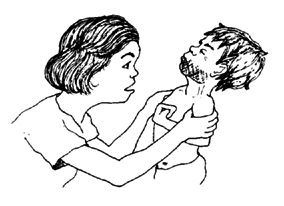
Holding breath
"Not giving attention during a tantrum sounds very nice. But my child gets so angry, he stops breathing and turns blue! I can't just do nothing!"
But doing nothing is often the best way to prevent your child from holding his breath more often!
The child will not hurt himself by holding his breath. At worst, he will lose consciousness and begin to breathe normally, long before the lack of air causes any damage.
Once a child learns that holding her breath frightens and confuses her parents, she is likely to repeal it every time she gets angry at them. (Many completely normal children do this.) We need to try not to show worry or concern when the child holds her breath and turns blue. Instead, we should wait until she gives up trying to frighten us and begins to breathe normally again. Then we can do something to show her how much we love her. But not while she is holding her breath!
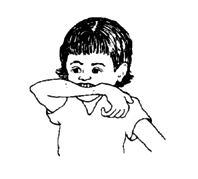
Head banging, biting, and other self-damage
Children may do these things for the same reason they hold their breath-to frighten and punish their parents.
Sometimes, however, children with brain damage, epilepsy or severe mental problems may form habits of biting themselves, banging their heads, pulling out their hair or other self-destructive behavior.
Whatever the cause, acts of self-destruction cannot be ignored. Parents should look for the most simple and calm way possible to gently stop the child from injuring herself. For example, they can hold the child's arms to keep her from biting herself.
However, often a behavioral approach helps solve these problems. Take care not to get excited or give the child extra attention when she hurts herself. At the same time, make every effort to reward positive behavior and to help the child gain self-confidence, learn new skills, play with toys and other children, and have friendly interaction with other people. Of course, some children's mental ability will not allow much learning or play. Showing these children a lot of affection, hugging them, talking and singing to them, and doing things with them that they like, at times when they are not harming themselves, may help them to stop such acts. Rewarding a child when she stops a self-destructive act may help a child to not act that way so often. But be sure to reward and give the child even more attention at times she has not been harming herself. When possible, get advice from a child psychologist.
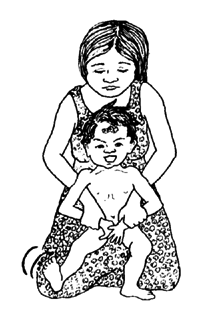
To stop a child who is hurting himself, hold him from behind tightly, but quietly, so that he does not see you and gets as little response from you as possible.
STRANGE BEHAVIOR
Children with different disabilities sometimes develop unusual habits or patterns of behavior. This is especially true for retarded or brain-damaged children who may be confused or frightened because they have difficulty understanding what goes on around them.
In helping children through such difficulties, first try to understand what might 'trigger' or be the cause of the behavior. For example:
Rocking

"Joel often starts rocking back and forth, and seems to escape into his own world! He then shows no interest in anything that is happening around him. Sometimes he rocks for almost an hour."
"When does this happen most?"
"Mainly when he is with a group of other children, or when there are guests. But sometimes when he's just alone."
Joel seems to withdraw into his world of rocking when things get too confusing, frightening, or even boring, for him. To stop rocking he may need to be helped, little by little, to discover that interaction and play with other persons and things can be enjoyable. But to avoid confusing and frustrating him, new people, toys, and activities will need to be introduced gently, a little at a time, by the persons he knows and trusts most. You might praise or reward him when he smiles or shows any interest in playing with other children, or with new toys. When he starts to rock, try to interest him in things you know he likes. (But make sure to spend more time doing things he likes with him when he is not rocking. Otherwise you will be encouraging him to rock more often to get your attention.)
Eye poking

"My 5-year-old daughter, Judy, is blind and somewhat retarded. She has a habit of poking her fingers deep into her eyes. As a result, her eyes often get infected."
For Judy, who lives in the dark, life is not always very interesting. She cannot see things to play with. When she tries to explore, she bumps into things. She has found that poking her eyes causes flashes of light, so she has made a game of this. Also, she has discovered that when she pokes her eyes her mother comes running. Sometimes mother slaps her hands, but at least she gets attention!
For Judy to learn not to poke her eyes, she will need a lot of help to find things to do that are more interesting and rewarding:
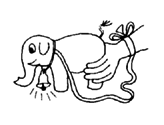
| toys that have interesting shapes and surfaces and that make different sounds. | |
| perhaps her own 'space' or part of the house where everything is always kept in the same place so she can learn her way around and find her toys. (See Chapter 30 on blindness.) | |
| giving her more attention and praise when she does not rub her eyes than when she does. |
![]()
Whenever your child develops behavior that you have trouble understanding, it may help to ask: What does the child gain from the behavior? What are his alternatives and in what way do they offer him less reward? And, how can we help provide alternatives that are more rewarding to him?

